Transformation of Soils and Mire Community Reestablishment Potential in Disturbed Abandoned Peatland: A Case Study from the Kaliningrad Region, Russia
Abstract
:1. Introduction
2. Material and Methods
2.1. Study Site
2.2. History of Land Use
2.3. Field Survey
2.4. Measurements and Laboratory Treatment
2.5. Soil Mapping Procedure
3. Results and Discussion
3.1. Spatial Distribution of Soils in the Vittgirrensky Peatland
3.2. Ecological Characteristics of Soils
3.3. Spatial Distribution of Underlying Sediments
3.4. Anthropogenic Transformation of the Soil Cover
3.5. Relationship between Present-Day Soils and Vegetation Cover
3.6. The Role of Present-Day Soils in Bog Vegetation Recovery
3.7. Site Rewetting Potential
4. Conclusions
Author Contributions
Funding
Data Availability Statement
Acknowledgments
Conflicts of Interest
Appendix A
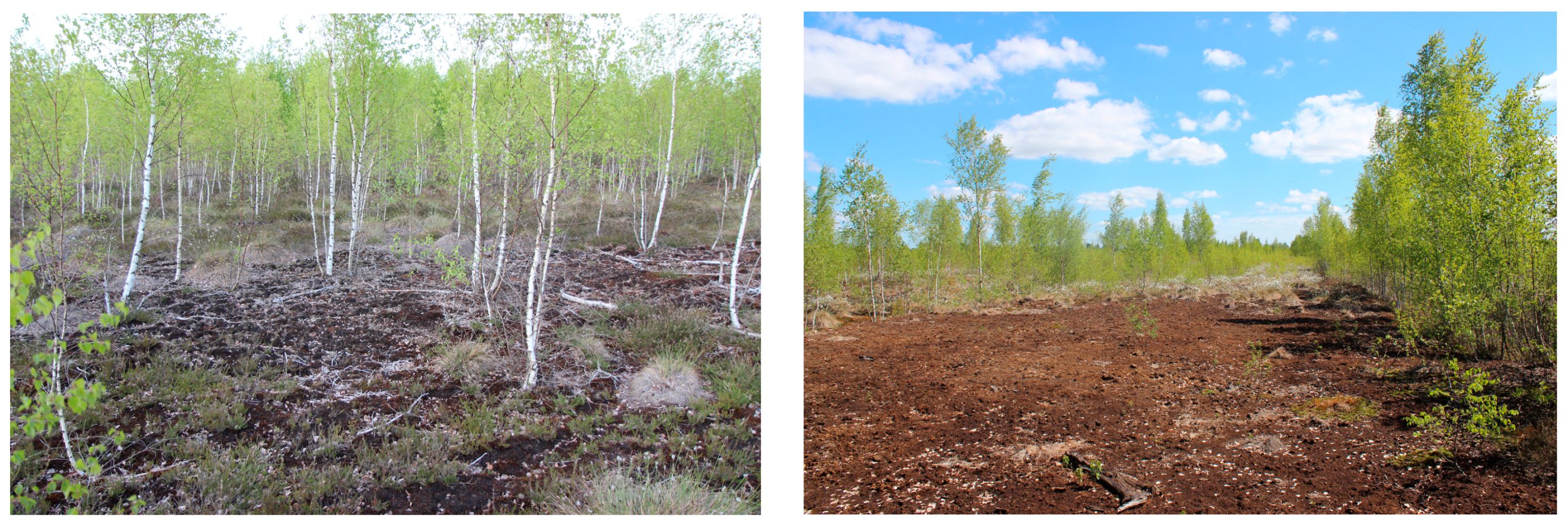

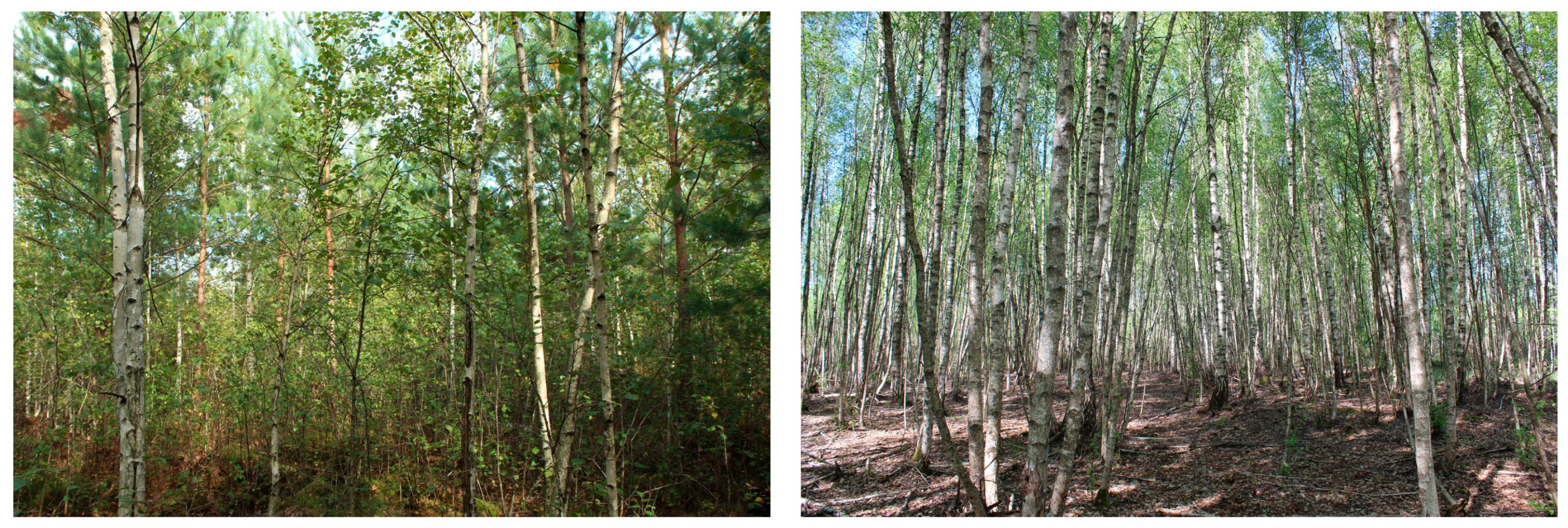
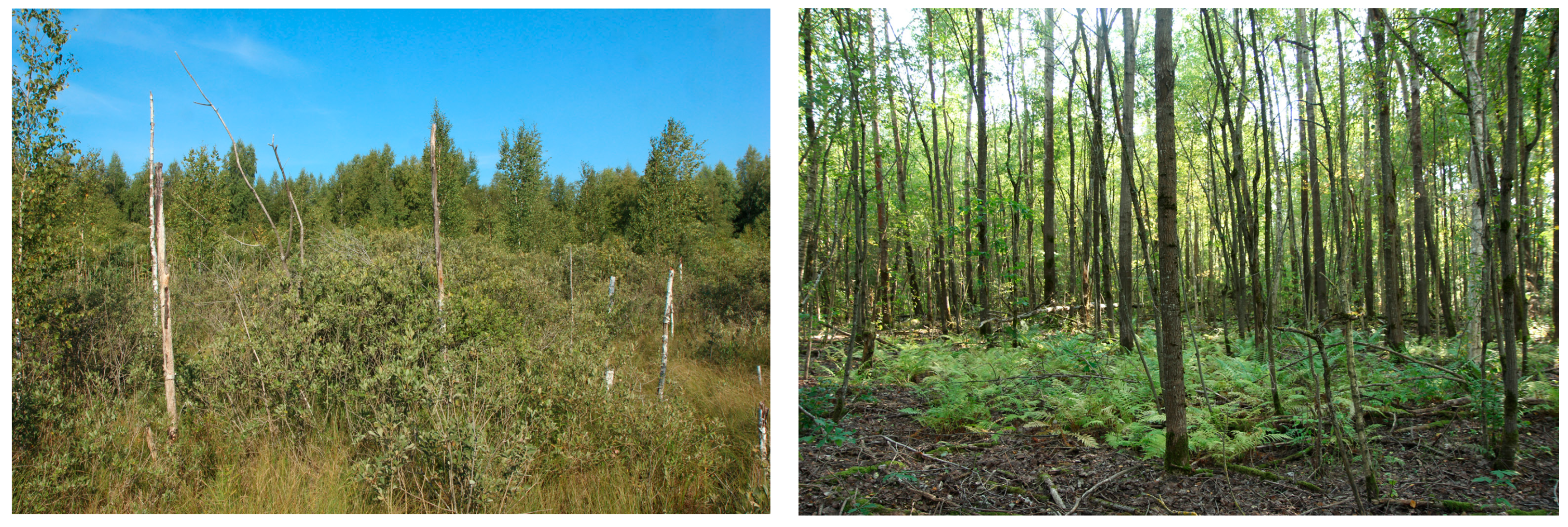
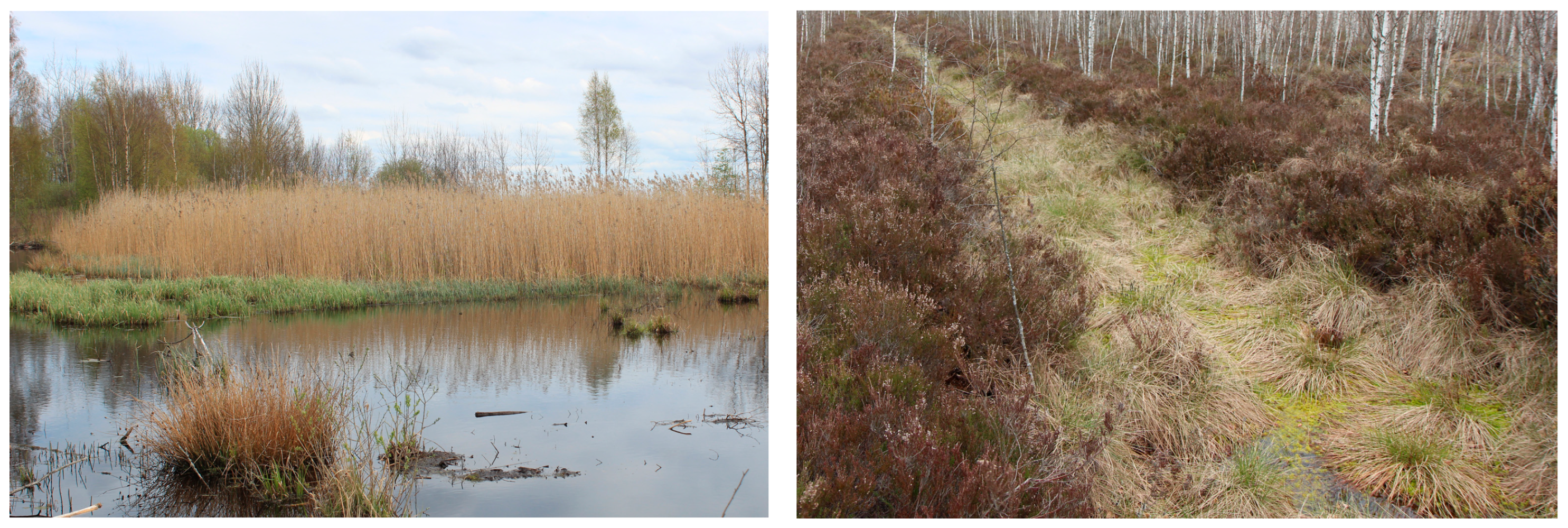
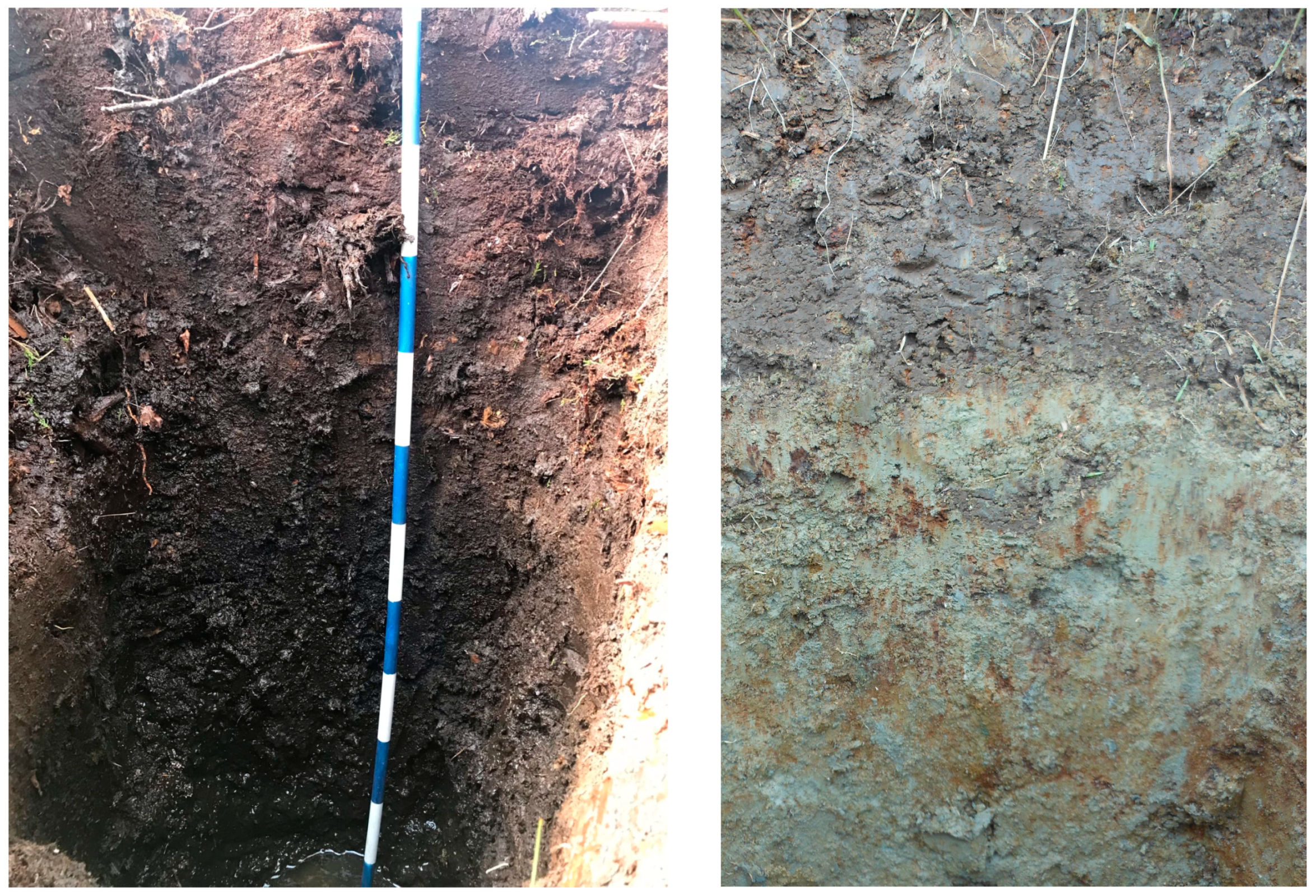
References
- Tubiello, F.N.; Biancalani, R.; Salvatore, M.; Rossi, S.; Conchedda, G. A worldwide assessment of greenhouse gas emissions from drained organic soils. Sustainability 2016, 8, 371. [Google Scholar] [CrossRef]
- Joosten, H.; Sirin, A.; Couwenberg, J.; Laine, J.; Smith, P. The Role of Peatlands in Climate Regulation. In Peatland Restoration and Ecosystem Services: Science, Policy and Practice; Bonn, A., Allott, T., Evans, M., Joosten, H., Stoneman, R., Eds.; Cambridge University Press: Cambridge, UK, 2016; pp. 66–79. [Google Scholar] [CrossRef]
- Poschlod, P.; Meindl, C.; Sliva, J.; Herkommer, U.; Jäger, M.; Schuckert, U.; Seemann, A.; Ullmann, A.; Wallner, T. Natural revegetation and restoration of drained and cut-over raised bogs in Southern Germany—A comparative analysis of four long-term monitoring studies. Glob. Environ. Res. 2007, 11, 205–216. [Google Scholar]
- Andersen, R.; Farrell, C.; Graf, M.; Muller, F.; Calvar, E.; Frankard, P.; Caporn, S.; Anderson, P. An overview of the progress and challenges of peatland restoration in Western Europe. Restor. Ecol. 2017, 25, 271–282. [Google Scholar] [CrossRef]
- Bonn, A.; Allott, T.; Evans, M.; Joosten, H.; Stoneman, R. (Eds.) Peatland Restoration and Ecosystem Services: Science, Policy and Practice; Cambridge University Press: Cambridge, UK, 2016; pp. 1–493. [Google Scholar] [CrossRef]
- Joosten, H.; Tapio-Biström, M.-L.; Tol, S. Peatland—Guidance for Climate Change Mitigation through Conservation, Rehabilitation and Sustainable Use; FAO and Wetlands International: Rome, Italy, 2012; pp. 1–100. [Google Scholar]
- Minayeva, T.Y.; Bragg, O.M.; Sirin, A.A. Towards ecosystem-based restoration of peatland biodiversity. Mires Peat 2017, 19, 1–36. [Google Scholar] [CrossRef]
- The Rossyanka Carbon Polygon. Scientific and Educational Project for Climate Active Greenhouse Gas Study. 2023. Available online: http://rosyanka.kantiana.ru/ (accessed on 2 July 2023). (In Russian).
- The Ministry of Science and Higher Education of the Russian Federation. Carbon Supersites: Russian Federation. 2023. Available online: https://carbon-polygons.ru/en/ (accessed on 2 July 2023).
- Romanova, E.A.; Vinogradova, O.L.; Frizina, I.V. Modern Landscapes in the Kaliningrad Region. In Terrestrial and Inland Water Environment of the Kaliningrad Region; Gritsenko, V.A., Sivkov, V.V., Yurov, A.V., Kostianoy, A.G., Eds.; The Handbook of Environmental Chemistry; Springer: Cham, Switzerland, 2018; Volume 65, pp. 97–119. [Google Scholar] [CrossRef]
- Napreenko, M.G. The Flora and Vegetation of the Raised Bogs in the Kaliningrad Region. Ph.D. Thesis, Immanuel Kant Baltic Federal University, Kaliningrad, Russia, 22 November 2002. (In Russian). [Google Scholar]
- Tanneberger, F.; Tegetmeyer, C.; Busse, S.; Barthelmes, A.; Shumka, S.; Moles Mariné, A.; Jenderedjian, K.; Steiner, G.M.; Essl, F.; Etzold, J.; et al. The peatland map of Europe. Mires Peat 2017, 19, 1–17. [Google Scholar] [CrossRef]
- Olenin, A.S. (Ed.) The Peat Stock Cadastre of the Kaliningrad Region; USSR: Moscow, Russia, 1952; pp. 1–63. (In Russian)
- Sirin, A.; Medvedeva, M.; Korotkov, V.; Itkin, V.; Minayeva, T.; Ilyasov, D.; Suvorov, G.; Joosten, H. Addressing peatland rewetting in Russian Federation climate reporting. Land 2021, 10, 1200. [Google Scholar] [CrossRef]
- Swenson, M.M.; Regan, S.; Bremmers, D.; Lawless, J.; Saunders, M.; Gill, L.W. Carbon balance of a restored and cutover raised bog: Implications for restoration and comparison to global trends. Biogeosciences 2019, 16, 713–731. [Google Scholar] [CrossRef]
- Napreenko, M.G.; Antsiferova, O.A.; Aldushin, A.V.; Samerkhanova, A.K.; Aldushina, Y.K.; Baranovskiy, P.N.; Napreenko-Dorokhova, T.V.; Panov, V.V.; Konshu, E.V. New Approaches to Sustainable Management of Wetland and Forest Ecosystems as a Response to Changing Socio-Economic Development Contexts. In Innovations and Traditions for Sustainable Development; Leal Filho, W., Krasnov, E., Gaeva, D., Eds.; World Sustainability Series; Springer: Cham, Switzerland, 2021; pp. 395–416. [Google Scholar] [CrossRef]
- Aslam, R.W.; Shu, H.; Yaseen, A.; Sajjad, A.; Ul Abidin, S.Z. Identification of time-varying wetlands neglected in Pakistan through remote sensing techniques. Environ. Sci. Pollut. Res. 2023, 30, 74031–74044. [Google Scholar] [CrossRef]
- Karte des Deutschen Reiches (Map of German Empire). Blatt: 5820031c. Mehlauken. 1893. Available online: https://www.davidrumsey.com/blog/2011/4/10/karte-des-deutschen-reiches-1893 (accessed on 23 September 2023).
- Germany 1:100,000 Series Map. Umgebung von Tilsit. 1934. Available online: https://digitalarchive.mcmaster.ca/islandora/object/macrepo:26717 (accessed on 23 September 2023).
- Certificate of the ‘Vittgirrensky’ Peat Stock; Kaliningrad Geological Office of the Peat Fund at the Government of the Russian Federation: Kaliningrad, Russia, 1949.
- Certificate of the ‘Vittgirrensky’ Peat Stock; Geological Agency of the Russian Federation, Northwestern Geological Office: Kaliningrad, Russia, 1962.
- Kornblum, E.A.; Mikhailov, I.S.; Nogina, N.A.; Targulyan, V.O. Basic Schedules of Properties of Morphological Soils Elements; Dokuchaev, V.V., Ed.; Soil Science Institute USSR: Moscow, Russia, 1982; pp. 1–60. (In Russian)
- FAO. Guidelines for Soil Description; FAO: Rome, Italy, 2006; Available online: https://www.fao.org/3/a0541e/a0541e.pdf (accessed on 1 September 2023).
- Ditzler, C.; Scheffe, K.; Monger, H.C. (Eds.) Soil Survey Manual; USDA Handbook No. 18; Government Printing Office: Washington, DC, USA, 2017; pp. 1–639.
- FAO. Peatlands Mapping and Monitoring: Recommendations and Technical Overview; FAO: Rome, Italy, 2020. [Google Scholar] [CrossRef]
- IUSS Working Group WRB. World Reference Base for Soil Resources 2014, Update 2015. International Soil Classification System for Naming Soils and Creating Legends for Soil Maps; World Soil Resources Reports No. 106; FAO: Rome, Italy, 2015; Available online: https://www.fao.org/3/i3794en/I3794en.pdf (accessed on 1 September 2023).
- Drzymulska, D. Peat decomposition—Shaping factors, significance in environmental studies and methods of determination; A literature review. Geologos 2016, 22, 61–69. [Google Scholar] [CrossRef]
- Review of Best Practice for SOC Monitoring; Soil Policy Evidence Programme Report; ADAS: Helsby, UK, 2020. Available online: https://www.gov.wales/sites/default/files/publications/2021-04/review-best-practice-soil-organic-carbon-monitoring.pdf (accessed on 1 September 2023).
- Michałowski, T.; Asuero, A.G.; Wybraniec, S. The titration in the Kjeldahl method of nitrogen determination: Base or acid as titrant? J. Chem. Educ. 2013, 90, 191–197. [Google Scholar] [CrossRef]
- Bargrizan, S.; Smernik, R.J.; Mosley, L.M. Constraining the carbonate system in soils via testing the internal consistency of pH, pCO2 and alkalinity measurements. Geochem. Trans. 2020, 21, 4. [Google Scholar] [CrossRef] [PubMed]
- Botch, M.S.; Smagin, V.A. Flora and Vegetation of Mires in the North-West Russia and Principles of Their Protection; Gydrometeoizdat: Saint Petersburg, Russia, 1993; pp. 1–225. (In Russian) [Google Scholar]
- Kõlli, R.; Astover, A.; Noormets, M.; Tõnutare, T.; Szajdak, L. Histosol as an ecologically active constituent of peatland: A case study from Estonia. Plant Soil 2009, 315, 3–17. [Google Scholar] [CrossRef]
- Ellenberg, H.; Weber, H.E.; Düll, R.; Wirth, V.; Werner, W.; Paulißen, D. Zeigerwerte von Pflanzen in Mitteleuropa. Scr. Geobot. 1992, 18, 1–258. (In German) [Google Scholar]
- Glime, J.M. Bryophyta—Sphagnopsida. Chapter 2–5. In Bryophyte Ecology. Volume 1. Physological Ecology; Glime, J.M., Ed.; Ebook Sponsored by Michigan Technological University and International Association of Bryologists. 2017. Available online: http://digitalcommons.mtu.edu/bryophyte-ecology/ (accessed on 2 July 2023).
- Panov, V.V. Restoration of Peatlands; Triada: Moscow, Russia, 2021; pp. 1–184. (In Russian) [Google Scholar]
- The European Environment Agency (EEA). EUNIS Habitat Types Search. 2023. Available online: https://eunis.eea.europa.eu/habitats.jsp (accessed on 2 July 2023).
- Dierßen, K.; Dierßen, B. Moore. Ökosysteme Mitteleuropas aus Geobotanischer Sicht (Peatlands. Ecosystems of Central Europe from a Geobotanical Perspective); Ulmer: Stuttgart, Germany, 2001; pp. 1–230. (In German) [Google Scholar]
- Gams, H.; Ruoff, S. Geschichte, Aufbau und Pflanzendecke des Zehlaubruches. Schriften Der Phys.-Ökon. Ges. Zu Königsberg I. Pr. 1929, 66, 1–193. (In German) [Google Scholar]
- Priede, A.; Mežaka, A.; Dobkeviča, L.; Grīnberga, L. Spontaneous revegetation of cutaway fens: Can it result in valuable habitats? Mires Peat 2016, 18, 1–14. [Google Scholar] [CrossRef]
- Price, J.S.; Heathwaite, A.L.; Baird, A.J. Hydrological processes in abandoned and restored peatlands: An overview of management approaches. Wetl. Ecol. Manag. 2003, 11, 65–83. [Google Scholar] [CrossRef]
- Laine, J.; Vasander, H.; Laiho, R. Long-term effects of water level drawdown on the vegetation of drained pine mires in southern Finland. J. Appl. Ecol. 1995, 32, 785–802. [Google Scholar] [CrossRef]
- Minkkinen, K.; Vasander, H.; Jauhiainen, S.; Karisto, M.; Laine, J. Post-drainage changes in vegetation composition and carbon balance in Lakkasuo mire, Central Finland. Plant Soil 1999, 207, 107–120. [Google Scholar] [CrossRef]
- Paal, J.; Jürjendal, I.; Suija, A.; Kull, A. Impact of drainage on vegetation of transitional mires in Estonia. Mires Peat 2016, 18, 1–19. [Google Scholar] [CrossRef]
- Maanavilja, L.; Aapala, K.; Haapalehto, T.; Kotiaho, J.S.; Tuittila, E.-S. Impact of drainage and hydrological restoration on vegetation structure in boreal spruce swamp forests. For. Ecol. Manag. 2014, 330, 115–125. [Google Scholar] [CrossRef]
- Karofeld, E.; Jarašius, L.; Priede, A.; Sendžikaitė, J. On the after-use and restoration of abandoned extracted peatlands in the Baltic countries. Restor. Ecol. 2016, 25, 293–300. [Google Scholar] [CrossRef]
- González, E.; Rochefort, L. Drivers of success in 53 cutover bogs restored by a moss layer transfer technique. Ecol. Eng. 2014, 68, 279–290. [Google Scholar] [CrossRef]
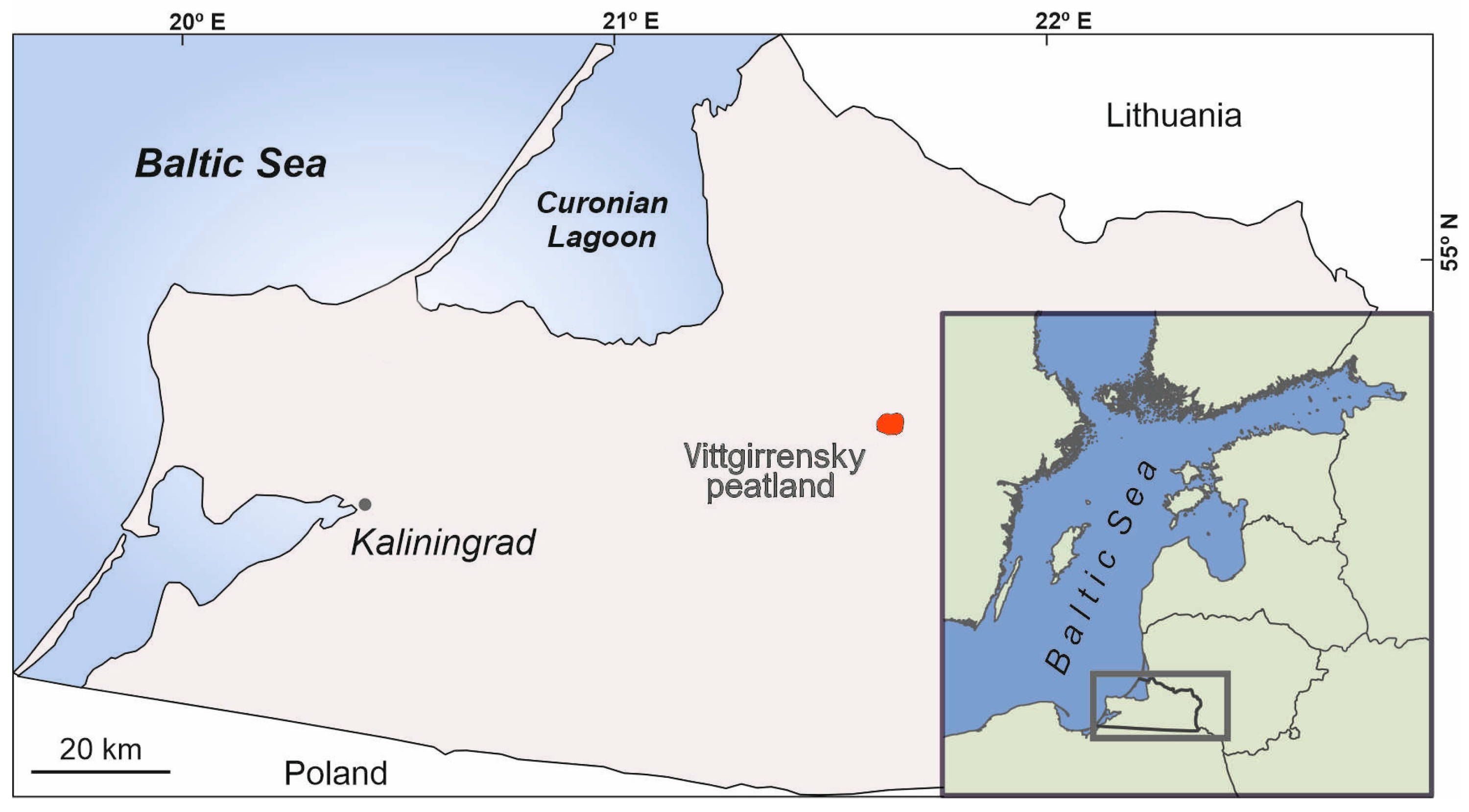
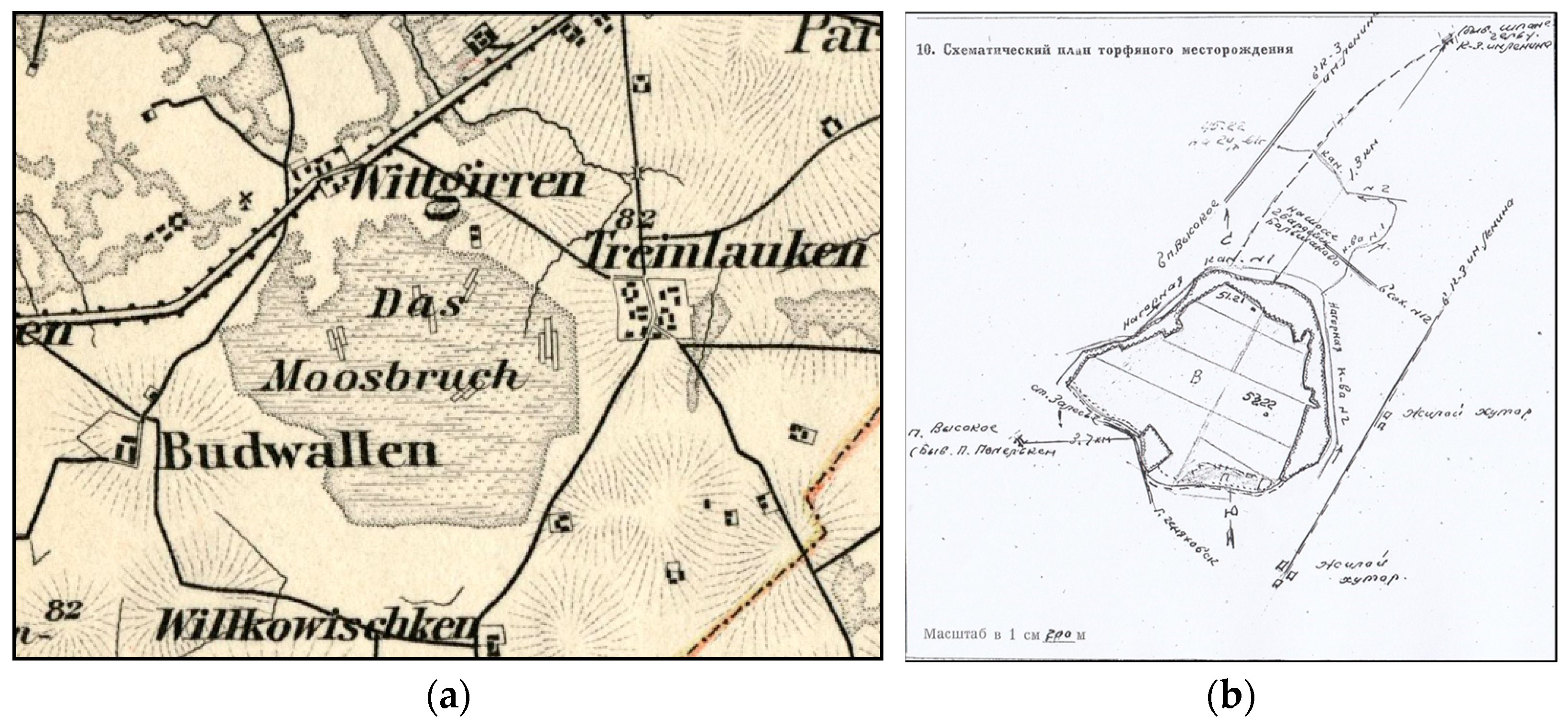


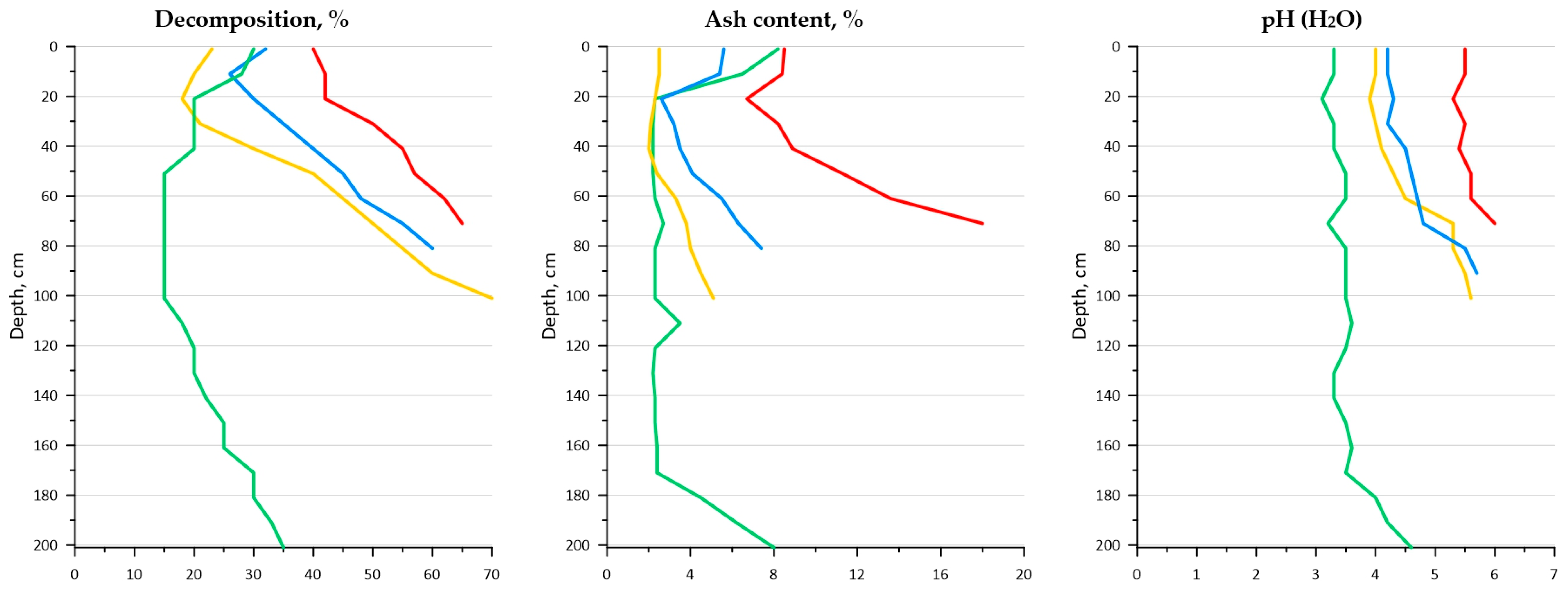
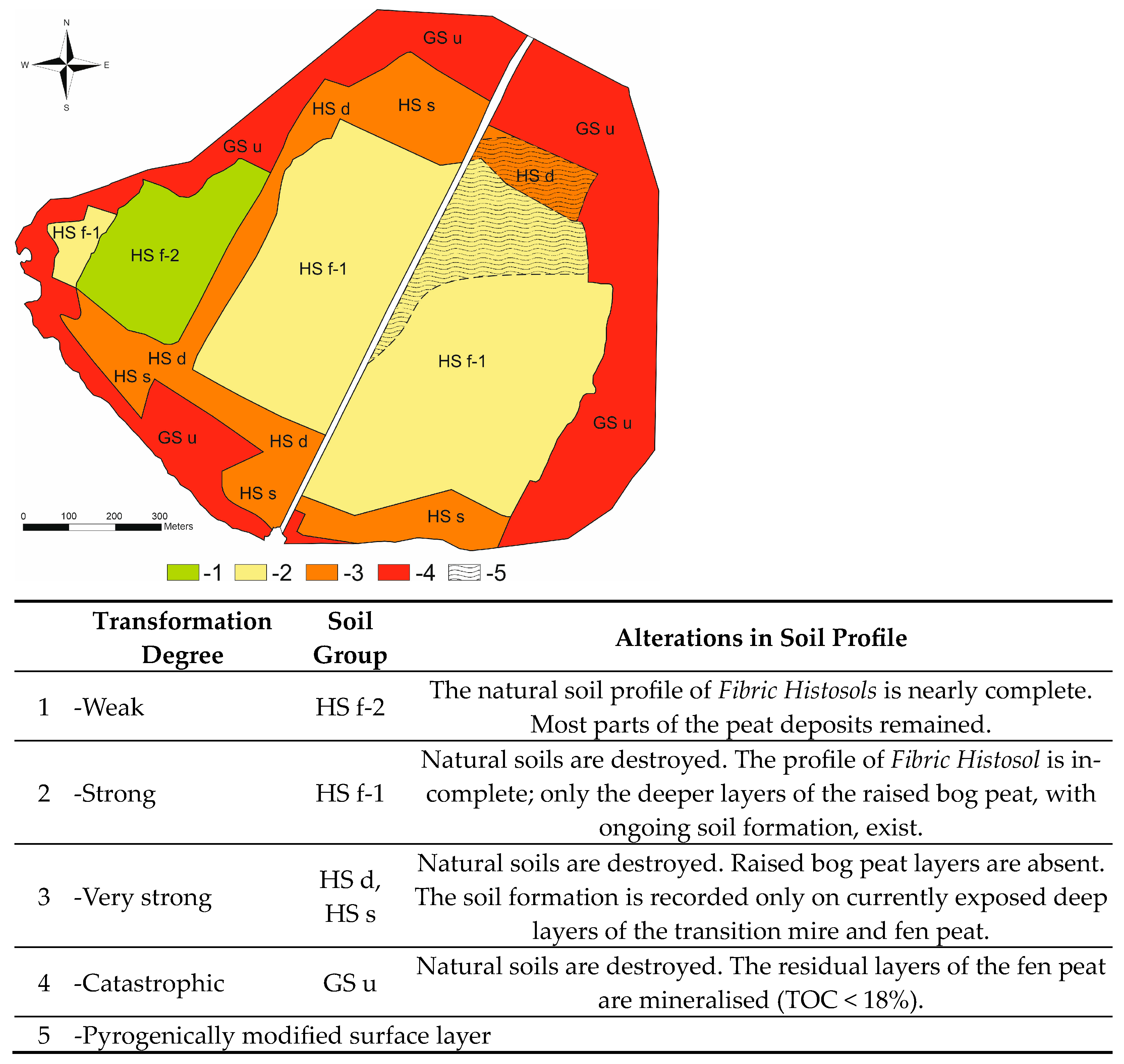


| Soils | Thickness of the Peat Horizons, m | |||
|---|---|---|---|---|
| Total Peat Layer | Oligotrophic Peat (Sphagnum fuscum + S. magellanicum − Eriophorum) | Oligo/Mesotrophic Peat (Carex–Betula − Pinus–Bryales) | Eutrophic Peat (Alnus–Phragmites − Carex–Hypnales) | |
| HS s | 0.55 ± 0.06 0.35 − 0.70 | - | - | 0.55 ± 0.06 0.35 − 0.70 |
| HS d | 0.85 ± 0.04 0.70 − 0.90 | - | 0.48 ± 0.03 0.40 − 0.60 | 0.37 ± 0.05 0.20 − 0.50 |
| HS fi-1 | 1.14 ± 0.03 0.80 − 1.60 | 0.40 ± 0.03 0.20 − 0.70 | 0.34 ± 0.05 0 − 0.55 | 0.40 ± 0.03 0.30 − 0.60 |
| HS f-2 | 2.00 ± 0.07 0.72 − 2.15 | 1.85 ± 0.21 0.72 − 2.00 | 0.10 ± 0.03 0 − 0.20 | 0.05 ± 0.04 0 − 0.20 |
| Soil Group | Predominant Vegetation | Ground Layer | Mire ‘True’ Species * |
|---|---|---|---|
| GS u | Wet shrublands | Tall graminoids, sparse hydrophilic bryophytes | Calamagrostis canescens IV, Calliergonella cuspidata IV, Polytrichum commune III, Sphagnum angustifolium IV, S. centrale IV, S. fallax IV, S. squarrosum IV, Warnstorfia fluitans IV |
| Dry shrublands | Leaf litter with sparse tall graminoids | Salix pentandra IV | |
| Wet forest (birch and aspen) | Hydrophilic forbs, graminoids, and sparse bryophytes | Polytrichum commune III, Sphagnum fallax IV, S. squarrosum IV | |
| HS s and HS d | Dry birch stand (different variants) | Leaf litter, woodland edge forbs, Calluna, Eriophorum | Calamagrostis canescens IV, Calluna vulgaris III, Eriophorum vaginatum V, Polytrichum commune III, P. strictum V, Sphagnum fallax IV |
| Fen-like communities (Junc.-dominated) | Juncus, Sphagnum carpet | Polytrichum commune III, Sphagnum angustifolium IV, S. centrale IV, S. cuspidatum V, S. magellanicum IV, S. squarrosum IV, S. teres IV | |
| Reed beds | Tall graminoids, sparse hydrophilic bryophytes | Calamagrostis canescens IV, Sphagnum squarrosum IV, Warnstorfia fluitans IV | |
| HS f-1 | Birch coppice (different variants) | Calluna, Eriophorum, Polytrichum | Calluna vulgaris III, Drosera rotundifolia V, Eriophorum vaginatum V, Ledum palustre V, Polytrichum strictum V, Sphagnum angustifolium IV |
| Bare-peat sites | Bare peat, Polytrichum, Campylopus introflexus | Polytrichum strictum V | |
| Hydrophilic communities in ditches | Sphagnum cuspidatum, Eriophorum vaginatum, bare peat (inundated) | Andromeda polifolia V, Carex rostrata IV, Eriophorum polystachyon IV, E. vaginatum V, Sphagnum angustifolium IV, S. cuspidatum V, S. fallax IV, S. fimbriatum III, S. magellanicum IV, S. squarrosum IV, Utricularia minor IV | |
| Fen-like communities (Eriophorum/sedge-dominated) | Sphagna, Eriophorum, Carex acuta, C. rostrata | Aulacomnium palustre IV, Calamagrostis canescens IV, Calluna vulgaris III, Carex rostrata IV, Calliergonella cuspidata IV, Drosera rotundifolia V, Eriophorum vaginatum V, Ledum palustre V, Polytrichum strictum V, Salix aurita III, S. pentandra IV, Sphagnum angustifolium IV, S. capillifolium IV, S. centrale IV, S. cuspidatum V, S. fallax IV, S. fuscum V, S. magellanicum IV, S. riparium IV, S. squarrosum IV, Warnstorfia fluitans IV, Utricularia minor IV | |
| HS f-2 | Dense closed-canopy stand | Calluna vulgaris, Eriophorum, Polytrichum, leaf litter | Calluna vulgaris III, Eriophorum vaginatum V, Polytrichum strictum V |
| Soil Unit | Main Ecological Limitations to Bog Vegetation Recovery | Measures to Address Limiting Factors | ||
|---|---|---|---|---|
| Physical and Chemical Properties of Soil | Hydrological Regime | Occurrence of Sphagnum Species | ||
| HS f-2 | Eutrophication risk (due to mineralisation in the upper peat layer) | Deep water table, root water uptake (by tree species) | No Sphagna found | Raising of the water table, reintroduction of Sphagna, elimination of tree biomass |
| HS f-1 Inundated sites | No limitation | Water table fluctuations | No limitation (different Sphagnum species forming micro-topography) | Stabilisation of the water table, prevention of flooding |
| HS f-1 Sites of coppice | Risk of local eutrophication (due to mineralisation and pyrogenic material in the upper peat layer) | Water table fluctuations in summer period, root water uptake (by tree species) | Occasional Sphagnum turfs | Raising of the water table, reintroduction of Sphagna, elimination of tree biomass (locally) |
| HS f-1; HS d Bare peat | Frost heaving, local pyrogenic degradation | Deep water table, capillary-fringe truncation | No Sphagna found | Raising of the water table, reintroduction of Sphagna (after Eriophorum recolonisation) |
| HS d Inundated sites | pH increasing | Water table fluctuations, flooding in winter period impeding peat formation | Sphagnum cuspidatum mats | Stabilisation of the water table, prevention of flooding |
| HS d Tree stand | Local pyrogenic degradation, eutrophication risk (due to mineralisation and pyrogenic material in the upper peat layer) | Deep water table, root water uptake (by tree species) | Occasional Sphagnum turfs in depressions near canals | Raising of the water table, recovery monitoring (for further decision) |
| HS s Flooded sites | Eutrophication risk (induced by carbonates from the underlying sediments) | Long-term or steady flooding | Occasional Sphagnum turfs | Recovery monitoring (for further decision) |
| HS s Tree stand | Eutrophication risk (induced by carbonates from the underlying sediments) | Deep water table in summer period, root water uptake (by tree species) | No Sphagna found | Raising of the water table (with further fen restoration) |
| GS u | Lack of peat, high pH level | Deep water table in summer period, root water uptake (by tree species) | No Sphagna found or scattered clumps (only species of eutrophic/mesotrophic habitats) | Stabilisation of the water table (with further fen restoration) |
| Predominant Vegetation | Type of Soil | Soil Properties | Hydrology | Mire ‘True’ Species, % | Potential for Sphagna Recolonisation | Expected Habitat |
|---|---|---|---|---|---|---|
| 1. Rapid recovery of the raised bog communities | ||||||
| Fen-like communities (Eriophorum/sedge-dominated) | HS f-1 | Favourable | Partially favourable | 70–80 | High |
|
| 2. Recovery of the raised bog and transition mire communities in the medium term | ||||||
| Fen-like communities (Juncus-dominated) | HS d HS s | Partially favourable | Partially favourable | 70–80 | Moderate to high |
|
| Ditch hydrophilic communities (and adjacent patches) | HS d | Favourable | Partially favourable | 50–70 | Moderate to high |
|
| Birch coppice sites | HS f-1 | Favourable | Partially favourable | <45 | Minor |
|
| 3. Recovery of the bog and transition mire communities in the long term | ||||||
| Bare-peat sites | HS f-1 | Partially favourable | Unfavourable | 0–50 | None |
|
| Dense birch stand (with pine) | HS f-2 | Partially favourable | Strongly unfavourable | <45 | None |
|
| 4. Recovery of the fen communities in the medium or long term | ||||||
| Wet shrublands | GS u | Unfavourable (lack of peat) | Partially favourable | 60–70 | Minor |
|
| 5. Mire restoration is presumably feasible (fen or/and transition mire) | ||||||
| Dry birch stand | HS s HS d HS f-1 | Partially favourable | Strongly unfavourable | <30 | None |
|
| Reed beds | HS s HS d | Partially favourable | Partially favourable | <40 | None to minimal |
|
| 6. Mire rehabilitation is doubtful | ||||||
| Wet forest | GS u | Unfavourable (lack of peat) | Unfavourable | <20 | None to minimal |
|
| Dry shrublands | GS u | Unfavourable (lack of peat) | Unfavourable | <20 | None |
|
Disclaimer/Publisher’s Note: The statements, opinions and data contained in all publications are solely those of the individual author(s) and contributor(s) and not of MDPI and/or the editor(s). MDPI and/or the editor(s) disclaim responsibility for any injury to people or property resulting from any ideas, methods, instructions or products referred to in the content. |
© 2023 by the authors. Licensee MDPI, Basel, Switzerland. This article is an open access article distributed under the terms and conditions of the Creative Commons Attribution (CC BY) license (https://creativecommons.org/licenses/by/4.0/).
Share and Cite
Antsiferova, O.; Napreenko, M.; Napreenko-Dorokhova, T. Transformation of Soils and Mire Community Reestablishment Potential in Disturbed Abandoned Peatland: A Case Study from the Kaliningrad Region, Russia. Land 2023, 12, 1880. https://doi.org/10.3390/land12101880
Antsiferova O, Napreenko M, Napreenko-Dorokhova T. Transformation of Soils and Mire Community Reestablishment Potential in Disturbed Abandoned Peatland: A Case Study from the Kaliningrad Region, Russia. Land. 2023; 12(10):1880. https://doi.org/10.3390/land12101880
Chicago/Turabian StyleAntsiferova, Olga, Maxim Napreenko, and Tatiana Napreenko-Dorokhova. 2023. "Transformation of Soils and Mire Community Reestablishment Potential in Disturbed Abandoned Peatland: A Case Study from the Kaliningrad Region, Russia" Land 12, no. 10: 1880. https://doi.org/10.3390/land12101880
APA StyleAntsiferova, O., Napreenko, M., & Napreenko-Dorokhova, T. (2023). Transformation of Soils and Mire Community Reestablishment Potential in Disturbed Abandoned Peatland: A Case Study from the Kaliningrad Region, Russia. Land, 12(10), 1880. https://doi.org/10.3390/land12101880





